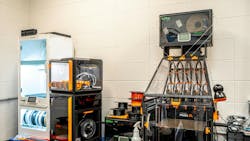St. Louis Metro’s Central Facility saving agency time and money
Mechanics working in the maintenance department at The Bi-State Development Agency of the Missouri-Illinois Metropolitan District’s (St. Louis Metro) Central Facility are providing creative solutions that solve complex problems and deliver bottom-line savings for the agency.
“Our Central Facility has approximately seven acres under one roof where we do the heavy lifting as it relates to maintenance, keeping our fleets out on the streets servicing our customers,” said St. Louis Metro COO Ron Forrest. “We would be lost without our mechanics and our maintenance team. They’re continually thinking of new and better things for us to be more efficient and effective in our maintenance processes.”
The agency notes that approximately 60 mechanics are employed at the facility, which serves as the agency’s main repair shop and also includes painting facilities and space for transmission overhauls. According to St. Louis Metro, one of the newest additions is 3D printing capabilities for manufacturing. Purchased in 2024, the 3D printers are being used to improve upon existing parts and to reproduce parts that have been discontinued by the manufacturer or are not readily available due to supply chain issues.
St. Louis Metro says the new technology has saved the agency over $48,000 by printing replacement parts in house versus purchasing them from the manufacturer and thousands more by printing creative new custom items to address evolving needs. To date, the agency has printed more than 7,500 parts in-house.
During extreme cold days, St. Louis Metro notes an air gap near the base of the steering column on the buses prevented operators from keeping their feet warm. A rubber seal available from the manufacturer to fix the problem costs more than $150 each and retrofitting 300-plus buses would have been a significant expense.
“Our innovative mechanics went to work to solve the problem and produced a rubber steering wheel seal themselves at a fraction of the cost we would have to pay to purchase it from the manufacturer,” said President and CEO of Bi-State Development Taulby Roach. “That solution alone helped to recoup almost the entire initial cost of the equipment within the first year of its use.”
St. Louis Metro says that in addition to delivering time and cost savings, the mechanics can control quality and provide components that are quickly becoming obsolete but are still necessary for maintenance on the agency’s fleet.
The agency is one of the few transit agencies that do in-house transmission rebuilds. The team does not use outside vendors and is able to control the quality of the product and components used in the rebuild process, so they can effectively replicate the performance of new transmissions.
According to the agency, a mentoring program in partnership with Amalgamated Transit Union will help to ensure the maintenance team continues to improve as new mechanics join the program. St. Louis Metro notes a mentor shows the mentee how to rebuild a transmission, the two work together to rebuild a transmission and then the mentee rebuilds a transmission under their mentor’s guidance.
“With our transmission program, we have great relationships with our manufactures and talk regularly about the performance of specific parts,” Roach said. “We’ve been able to provide insight into solutions to improve these transmissions.”
St. Louis Metro notes the two paint booths at the Central Facility also have been outfitted with equipment and technology to enhance operations. The primary paint booth can accommodate a 60-foot bus. The smaller paint booth is normally used for body panels and painting smaller components while an air operated man lift provides improved access.
The booths have a filtering system that creates a clean environment for the paint specialists painting the vehicles. The booths also function as a big oven, helping to bake the paint onto the vehicles and allowing the multicolor painting to be completed faster.
